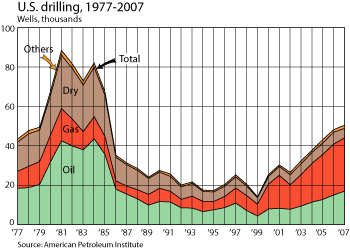The good times roll on, but the pace is slowing, even as operators demonstrate strong optimism in their 2008 drilling plans. In fact, in many cases, we had to dampen operators’ apparent enthusiasm in their planned increases-we just thought that such steep increases would not be sustainable (see raw data in the operators’ tables). Drilling levels for 2007 came in at 49,195, remarkably close to our midyear revision to 49,215 wells in August. Some areas showed a declining rig count in the latter half of the year, indicating caution by the operators.
While last year the industry projected a 7% increase in drilling activity, spending this year is expected to slow slightly to 6.5%, according to Citi Investment Research (see page 50). This year’s World Oil survey drew out increases in planned drilling for 2008 in most regions of the country, led by Texas with a forecast increase of 6.8%.
The present expansion seems to be better regulated than the last boom in the late 1970s and is near the drilling level achieved in 1979.
World Oil’s forecast for 2008 shows:
- US drilling activity will continue to expand, to 52,394 wells.
- US rig count will average 1,854 rigs, up 4.9% from 2007.
- Canadian drilling will continue to drop, by almost 17% from last year, dragging down what otherwise would be a continued expansion outside the US.
US prices. In its 2007 Price Summary, the Energy Information Administration (EIA) calculated a 2007 average WTI price of $72.30/bbl, a 9.5% increase over 2006. World Oil’s monthly WTI price tracking shows the steady increase throughout 2007 to a high of $94/bbl in December. The year began with oil prices near $55/bbl. Prices increased steadily to $74/bbl in July, but a slight correction in August dropped prices $2. In September, increases began again with a jump to $79/bbl and prices rose to over $90 by year’s end. In December, a single $100/bbl contract sale caught the world’s attention, but that faded quickly.
The firm Groppe, Long & Littell forecasts that oil prices will average $70/bbl (WTI) in 2008. As we enter 2008, US oil inventories are falling, but are within the normal range, and prices seem to have disconnected from supply-demand fundamentals. Since oil is priced in dollars, the dollar’s drop in value may, in part, be supporting continued high oil prices.
Natural gas prices continue strong, averaging $6.37/Mcf at the wellhead and $7.17/Mcf at Henry Hub, according to EIA.
Comparing peaks. While examining the US drilling graph, readers should note important differences between the 1979-1982 peak and the present expansion. Drilling practices were very different after the oil crises of 1973 and 1979, compared with today. In that earlier era, the industry’s focus was on oil exploration. In 1981, the industry drilled over 30,000 dry holes as a testament to that effort. Most wells were vertical holes, and oil wells exceeded gas wells by two to one.
| Forecast of 2008 US wells and footage to be drilled |
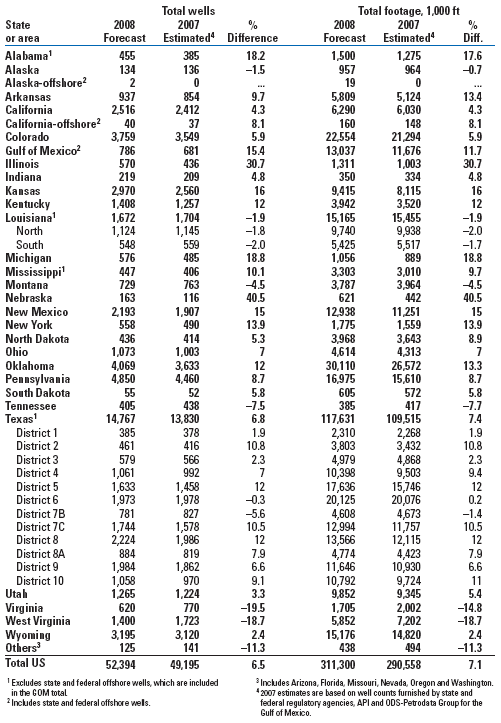 |
|
This present expansion has very different drivers, and the drilling results have flipped. The industry’s focus now is on natural gas and resource play development: drilling for shale gas and CoalBed Methane (CBM). In addition, new technology, especially the development and application of horizontal drilling, gives this expansion a very different character. Dry hole numbers have dropped to just over 3,100 wells, according to the American Petroleum Institute, while gas wells dominate oil wells two to one.
US operators survey. World Oil’s survey of 20 US major drillers (integrated companies and independents with large drilling programs) and 129 independents received a strong response. Like last year, major drillers continue to focus on development drilling with only 2.4% of the almost 13,700 wells designated as wildcats. Overall, the major drillers plan a 9.7% increase in wells drilled. They also plan to increase horizontal drilling by 40% to nearly 3,000 wells.
Compared with last year’s survey, independent operators plan a 30% expansion to almost 3,000 wells. They will be more aggressive explorers than the major drillers and are planning 20% of their new wells as wildcat tests. This difference is most striking offshore, where independents plan to increase GOM wildcats to 45 wells, while the major drillers plan only 32. Most drilling will be offshore Louisiana. Undergirding the operators’ optimism is data from ODS-Petrodata that shows increasing quarterly numbers for wells drilled during the past three quarters of 2007. This trend bodes well for a turnaround in GOM drilling.
What 20 US major drillers1 plan for 2008
Click Table to Enlarge. |
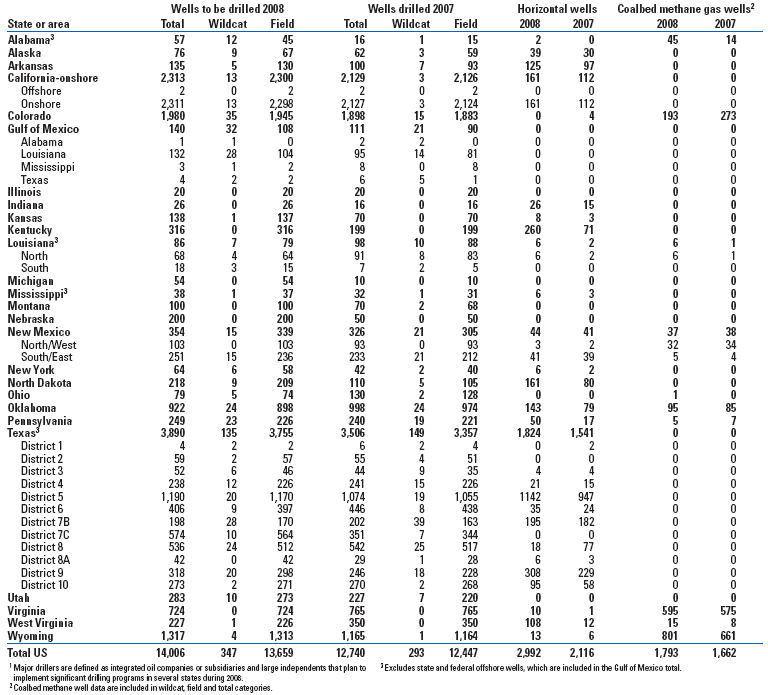 |
|
Onshore, the major drillers will focus wildcat drilling in Texas, while independents will focus on Kansas first, then Texas. In our survey, majors and independents plan to drill a combined total of 16,676 wells, some 32% of the drilling forecasted for 2008.
US rigs. Getting a rig to drill your well should not be an issue in 2008. Onshore rig rates have softened, and there is sufficient equipment and, hopefully, crews available to drill most wells.
Offshore GOM rig availability is tightening as high-end jackups move out of the Gulf to more lucrative markets and as utilization in the basin increases, now at around 70%. On the shelf, the moving of higher-spec jackups out of the Gulf leaves lower-spec and older rigs to handle the remaining drilling. According to ODS-Petrodata, the number of independent-leg cantilever rigs has dropped to 32 from 34 in August 2007, which has shifted the proportion of mat-based rigs to 56% (47 of 84 available jackups) of the fleet. At the beginning of 2008, deepwater drilling continues strong with the number of US GOM deepwater semisubmersibles and drillships working stable at 30, but down one rig from August 2007. A few new deepwater rigs on long-term contracts will enter the GOM market in 2008.
In the Gulf of Mexico, our respondents plan to drill over 200 wells. Major drillers will focus on development drilling, while the majority of wells independents drill will be wildcats. Deep water is drawing most of the money due to high drillship and semi dayrates, but the shelf still keeps more rigs (jackups) busy.
Area highlights. As mentioned before, US drilling in this present expansion has turned dramatically to development drilling with resource plays in CBM and shale gas leading the way. CBM development is focused in Colorado, Kansas, New Mexico and Wyoming. Shale play operators are active in the Fayetteville Shale of Arkansas and Oklahoma (Arkoma Basin) and the Barnett Shale of Texas (Fort Worth Basin). The Antrim Shale is prevalent across the northeastern US and is being developed at a slower pace.
What 129 US independents1 plan for 2008
Click Table to Enlarge. |
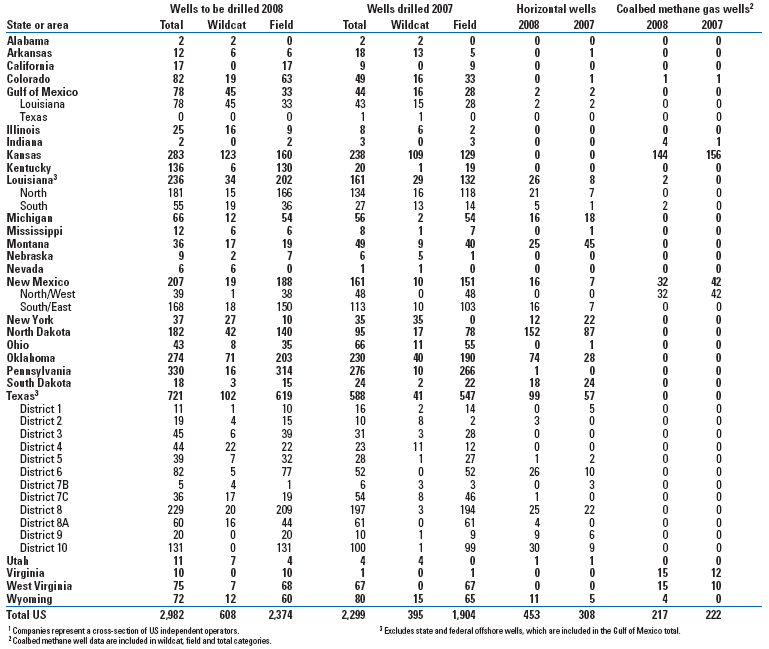 |
More wells will be drilled in Texas than in any other state. More than 4,600 wells are planned with the bulk of those (more than 1,500 wells) in the Barnett Shale play of Districts 5 and 6. Adjacent Districts 7B and 9 will have almost 500 wells drilled; most of those will be in the shale play. West Texas Districts 7C and 8 will see more than 1,000 wells drilled.
According to the Texas Alliance of Energy Producers, the Texas Petro Index set a new high, rising to 241.1 in December 2007, up from 227.6 last June. In a recent press conference, economist Karr Ingham noted that oil and gas activity increased in response to rising prices, expanding the state’s oil and gas economy by 8.1% in 2007. Crude oil prices were 50% higher at year-end, with WTI passing $90 last November and averaging nearly $70/bbl for the year. The rig count responded and is approaching 900, a 10% increase over 2006.
Fayetteville Shale development continues strong in northwestern Arkansas with over 900 wells planned for this year. A relatively new play has developed in Oklahoma’s Woodford Shale, where operators are drilling horizontal wells with legs of 1,000 to 2,500 ft.
In the Bakken Shale play of North Dakota, operators are still hampered by pipeline constraints. To move oil to markets, operators are forced to discount their production because of competition for pipeline space. The number of producing wells continues to grow, as does their output. New pipelines are being built with some relief expected in 2008, but major new capacity won’t be available until 2009.
California will see a drilling increase to more than 2,300 development wells drilled. Most of this drilling is to support heavy oil steam-flooding operations.
More than 3,000 wells are planned for Colorado. Many of these wells will be in CBM plays in the eastern part of the state.
| Active Gulf of Mexico operators and wells drilled in 2007 |
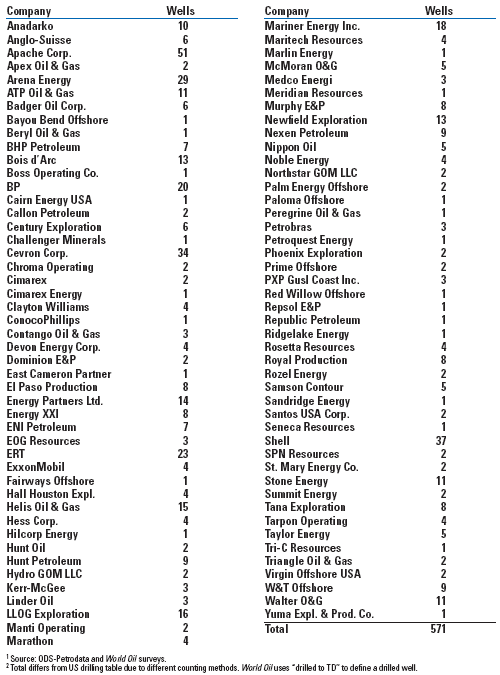 |
|
About these statistics. World Oil’s tables are produced with the aid of data from a variety of sources, including the American Petroleum Insititute, Groppe, Long & Littell, ODS-Petrodata Group, IHS Energy, the Texas Railroad Commission, other state and federal regulatory agencies, as well as international agencies. Most importantly, operating companies with drilling programs responded to this year’s survey. Please note credits and explanations in the table footnotes. We thank all contributors for their time and effort in providing data and analysis for this report.
World Oil editors try to be as objective as possible in the estimating process to present what they believe is the most current data available. It is realized that sound forecasting can only be as reliable as the base data. In this respect, it should be noted that well counting is a dynamic process and most historical data will be continually updated over a period of several years before “the books are closed” on any given year.
|




